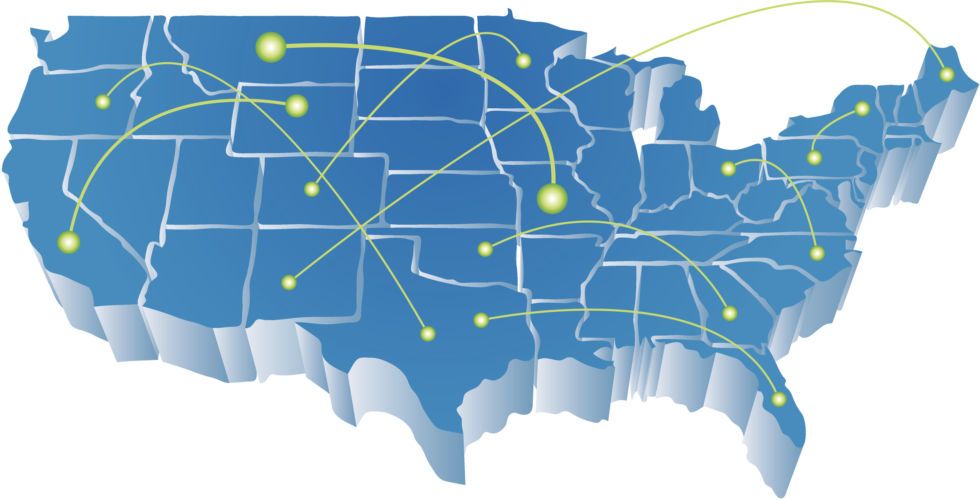Even at 25Mbps, 43 percent of the US had zero ISPs or just one.
If you live in the US and want home Internet service at speeds of at least 100Mbps, you will likely find one Internet service provider in your area or none.
The latest Internet Access Services report was released by the Federal Communications Commission last week. The report’s broadband competition chart shows that 44 percent of developed Census blocks had zero home broadband providers offering download speeds of at least 100Mbps and upload speeds of at least 10Mbps.
Forty-one percent of developed Census blocks had one ISP offering such speeds, for 85 percent with zero or one ISP. The remaining 15 percent had two or three providers at that level as of 2016. That’s up a bit from June 30, 2016, when about 12 percent of Census blocks had at least two providers of 100Mbps services.
While the FCC tracks the deployment of 100Mbps Internet, the commission uses 25Mbps downstream and 3Mbps upstream as the primary speed threshold for judging broadband progress. FCC Commissioner Jessica Rosenworcel has called for raising the FCC’s broadband download standard to 100Mbps, but the FCC has kept it at 25Mbps.
At the 25Mbps/3Mbps level, 56 percent of developed Census blocks had at least two providers in the latest data. That’s up from 42 percent, the percentage with at least two providers six months previously. Thirty percent had exactly one provider, and 13 percent had none.

The data is based on the extensive Form 477 filings that ISPs must make to the FCC. While this is the FCC’s best data on deployment and competition, it’s always about a year behind the present time—the latest report covers broadband access as of December 31, 2016.
Despite those pesky net neutrality rules, there were undoubtedly new broadband deployments and speed increases in existing deployments last year, so the numbers would look better if they went through 2017. But the FCC data can also overstate broadband competition slightly because it counts ISPs as serving an entire Census block even if it only serves one home in the block. There are more than six million developed Census blocks in the US.
One analysis based on the FCC’s June 2016 data found that more than 10.6 million US households had no access to wired Internet service with download speeds of at least 25Mbps, and an additional 46.1 million families live in areas with just one provider offering those speeds.
DSL in more Census blocks than cable or fiber
The latest FCC report covering December 2016 has another table that provides some sense of consumers’ kinds of broadband choices. It shows that 63.2 percent of developed Census blocks had one cable provider, but only 3.8 percent had two, and 0.3 percent had three:

With fiber-to-the-home, more than 81 percent of developed Census blocks had no providers, while 18.3 percent of blocks had one. DSL and satellite were in a higher percentage of developed Census blocks than cable or fiber.
The data also shows that consumers frequently choose higher speeds when they can do so. Of 105.7 million fixed Internet connections, including business and residential locations, 38.9 million had download speeds between 25Mbps and 99Mbps. Another 24.5 million connections were 100Mbps or higher:

For home Internet connections, “the median downstream speed was 50Mbps, and the median upstream speed was 5Mbps,” the report said. About 62 percent of residential broadband connections had speeds of at least 25Mbps downstream, and 3Mbps upstream, and “[a]bout 24 percent of all residential fixed connections had a downstream speed of at least 100Mbps.”
FCC Chairman Ajit Pai recently declared that broadband is being deployed to all Americans “in a reasonable and timely fashion,” and he claimed that his repeal of net neutrality rules is spurring deployment. But the FCC has no data for the time after the net neutrality repeal. The examples of new deployment cited by Pai’s FCC were mostly projects that began during the Obama administration.
Satellite’s impact on broadband data
The nationwide presence of satellites can make the broadband competition look better than in the FCC reports. In previous years, we’ve been told by the FCC that the broadband competition chart in each report excludes satellite services.
But that was incorrect, as the FCC now tells us that the chart has always included satellite within its count of how many providers serve each Census block at different speeds. The FCC could provide the competition data with and without satellite, but it hasn’t done so.
So far, that has only really affected the competition data for lower speeds. The FCC says satellite providers offer 10Mbps rates in 99.1 percent of developed Census blocks.
But in future reports, the satellite could have a sizable impact on the 25Mbps/3Mpbs competition data. HughesNet began offering 25Mbps/3Mbps service in March 2017, for example. That will appear as an option for consumers in future reports, even though few people would choose satellite over cable or fiber because of satellite’s latency and low data caps.
The fact that Internet consumers generally don’t consider satellite a worthy alternative to cable or fiber broadband can be seen in other data from the FCC report. Satellite accounts for about 1.7 percent of all residential fixed Internet connections with speeds of at least 10Mbps despite being available in more than 99 percent of the country. Cable accounts for 72.3 percent, fiber-to-the-premises for 12.8 percent, and DSL is 12.7 percent. There were 78.2 million residential connections of at least 10Mbps downstream and 1Mbps upstream.
Fixed wireless services account for about 0.4 percent of 10Mbps-and-over connections. Fixed wireless’ presence in the US broadband market is also set to grow as major carriers like AT&T and Verizon expand the use of wireless home Internet services in less densely populated areas.
